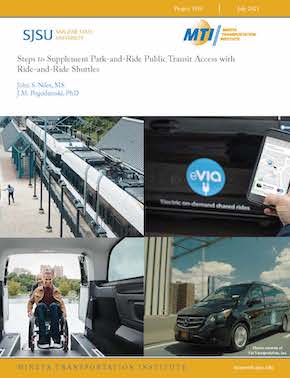- 408-924-7560
- mineta-institute@sjsu.edu
- Donate
Steps to Supplement Park-and-Ride Public Transit Access with Ride-and-Ride Shuttles
Public transit ridership in California declined in the five years before the pandemic of 2020–21 and dropped significantly further after the pandemic began. A sharp downward step in the level of transit boarding occurred after February 2020, and continues to the date of this report as a result of the public-health guidance on social distancing, expanded work-at-home, and a travel mode shift from public transit to private cars. A critical issue has come to the foreground of public transportation policy, namely, how to increase the quality and geographic reach of transit service to better serve the essential trips of mobility disadvantaged citizens who do not have access to private vehicle travel. The research focus of this report is an examination of the circumstances where fixed route bus route service could cost-effectively be replaced by on-demand microtransit, with equivalent overall zone-level efficiency and a higher quality of complete trip service. Research methods were reviews of documented agency experience, execution of simple simulations, and sketch-level analysis of 2019 performance reported in the National Transit Database. Available evidence is encouraging and suggestive, but not conclusive. The research found that substitutions of flexible microtransit for fixed route buses are already being piloted across the U.S., with promising performance results. The findings imply that action steps could be taken in California to expand and refine an emphasis on general purpose microtransit in corridors and zones with a relatively high fraction of potential travelers who are mobility disadvantaged, and where traditional bus routes are capturing fewer than 15 boardings per vehicle hour. To be sufficiently productive as fixed route replacements, microtransit service technologies in the same or larger zones need to be capable of achieving vehicle boardings of five per hour, a challenge worth addressing with technology applications. Delivery of microtransit service can be undertaken through contracts with a growing set of private sector firms, which are developing processes to merge general purpose customers with those now assigned to ADA-required paratransit and Medi-Cal-supported non-emergency medical transport.
JOHN S. NILES
John Niles is Founder and President of Global Telematics, a policy research consultancy based in Seattle that focuses on designing policies and actions for transportation improvement. As a Research Associate at Mineta Transportation Institute he has led team studies on transit oriented development, urban freight mobility planning, bus rapid transit, and park-and-ride productivity analysis. He is co-author of the textbook The End of Driving: Transportation Systems and Public Policy Planning for Autonomous Vehicles (Elsevier, 2018), as well as many technical reports and articles.
J. M. POGODZINSKI
Mike Pogodzinski is a Professor of Economics at San José State University and a Research Associate at Mineta Transportation Institute. His transportation research has included work on the employment impacts of high-speed rail construction, the impact on ridership of park-and-ride facilities, and the economics of bike sharing. He also does research on state rainy-day funds and the impact of municipalities on school performance.
-
Contact Us
San José State University One Washington Square, San Jose, CA 95192 Phone: 408-924-7560 Email: mineta-institute@sjsu.edu






